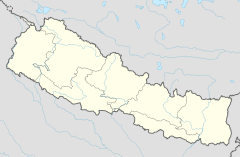Dolakha_Bhimsen_Temple
Dolakha Bhimsen Temple
Temple in Nepal
Dolakha Bhimsen Temple (Nepali: दोलखा भिमसेन मन्दिर) is located in the Bhimeshwar municipality of Dolakha in Nepal, approximately 4.5 km (2.8 mi) east of Charikot.[1] The temple is roofless in the center and it houses a triangular-shaped stone idol of Bhindyo,the patron god of trade, commerce and of fortunes. The Newar community in general and the business community in particular revere the deity for good business. The idol is believed to resemble three deities: Bhimeshwar in the morning, Mahadeva throughout the day, and Narayana in the evening.[2] The temple attracts around 5,000 worshippers every week.[3]

